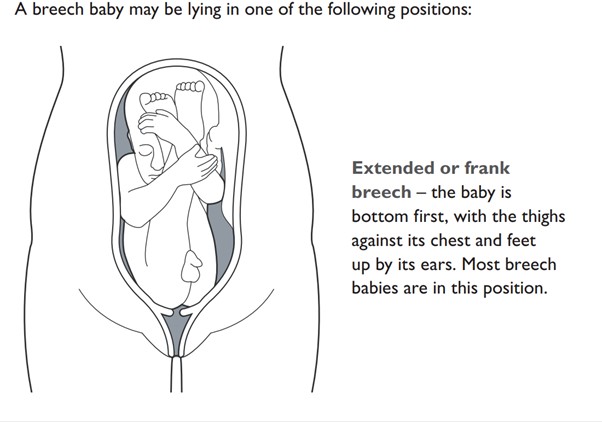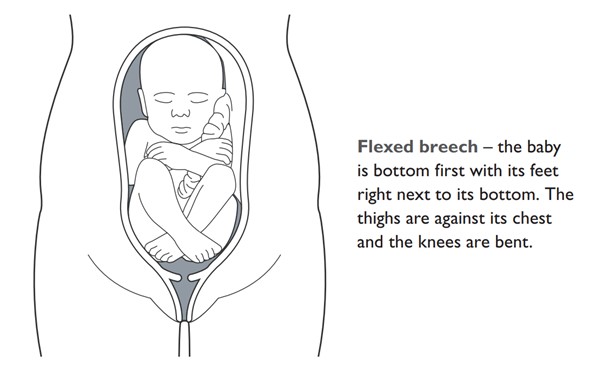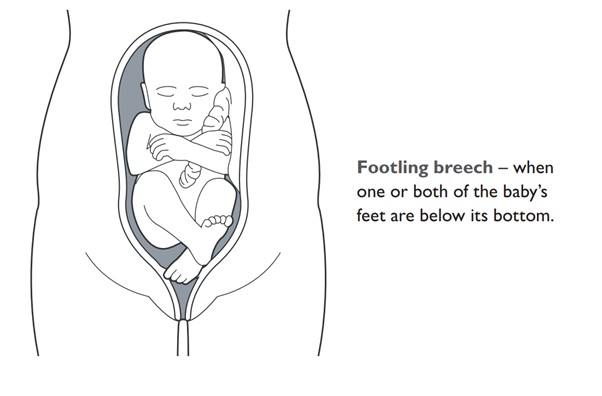What happens when your baby is in a breech position.
Breech Baby
Towards the end of the pregnancy most babies are usually in a position with their head down. In around 3 – 4 out of 100 of pregnancies the baby is in a position with their bottom down. This is called a breech position or breech baby.
What are your options?
At your 36-week appointment if your baby is in a breech position, your midwife will refer you to Day Assessment Unit in the Royal Infirmary of Edinburgh or to the Labour Ward at St John’s Hospital. You will be seen by a midwife who will discuss the following options with you:
- Trying to turn your baby inside your abdomen – a procedure called External Cephalic Version or ECV.
- Planning a caesarean birth
- Planning a vaginal birth
Each option has benefits and risks. Your choice of options will depend on your pregnancy circumstances and the exact position of your baby. The midwife who is seeing you will take time to discuss these options with you in detail and will answer your questions.
After discussion, you may choose to have the ECV procedure to try and turn your baby. Information about your appointment at the ECV Clinic at the Royal Infirmary of Edinburgh or on the Labour Ward at St John’s Hospital is given in the next paragraph.
You may also choose not to try the procedure and to plan a vaginal breech birth or a caesarean section. Please, read the information leaflet below where you will find more information about each option, including what happens if you go in labour early and what to expect in labour with a breech baby.
The Royal College of Obstetricians & Gynaecologists website and leaflet provide up-to-date information based on research and evidence.
Breech baby at the end of pregnancy patient information leaflet | RCOG
Breech baby patient information leaflet (rcog.org.uk)
NHS Lothian ECV Appointment
If your baby is in a breech position at 36 weeks, you will normally be offered a procedure to try and turn the baby in your abdomen. This procedure is called External Cephalic Version or ECV.
It is done by an experienced doctor (Consultant Obstetrician) either in the ECV Clinic at the Royal Infirmary of Edinburgh or on the Labour Ward at St John’s Hospital. The appointment will take a minimum of two hours; this will include an ultrasound scan, discussion of options and ECV if you choose to have this. Prior to the ECV procedure, you will be offered a cardiotocograph (CTG) trace to check the baby’s heart rate.



pregnancy’. Patient Information Leaflet. London: RCOG; July 2017, with the permission of the College.
What happens during the ECV procedure?
During ECV, you will be offered medicine to relax your abdomen (terbutaline, given as injection under your skin).
Your doctor will place their hands on your abdomen and gently encourage the baby to turn into a position where their head is down, not their bottom. During the ECV you can play relaxation music of your choice if you would like this.
The procedure can be uncomfortable and a few women and birthing people find it painful but your doctor will check how you are throughout the procedure. If you find it too uncomfortable, tell your doctor and the procedure can be stopped. You may decide to try again on another day.
Around half of all breech babies can be successfully turned using this technique. It is more successful if you have given birth before. In 1 in 200 cases, the procedure will lead to a caesarean birth if there is a concern about you or the baby.
An ultrasound scan will be done after the procedure to check that the baby has turned and we will check the baby’s heart rate.
Can I go home after the procedure?
You will usually be able to go home the same day.
If you are rhesus-negative you will be advised to have anti-D following the ECV.
If you have any bleeding, abdominal pain or notice reduced movements from your baby, you should immediately contact Obstetric Triage at the Royal Infirmary of Edinburgh (0131 242 2657) or the Labour Ward at St John’s Hospital (01506 524 125).
If the ECV has been successful, you will be offered another ultrasound in one week at Day Assessment Unit to check the baby has stayed in the head down position. If you are having your baby at St John’s Hospital you will be offered a bedside scan when you attend in labour.
What happens if the procedure does not work?
If it is not possible to turn your baby, your doctor will discuss your options with you. Your doctor may offer to try and turn your baby again another day. They will also discuss the option of having a vaginal birth or they may recommend a planned caesarean birth.
Your doctor will make recommendations depending on a number of factors. These include the exact position of your baby (type of breech position), if you have had a vaginal birth before and other circumstances related to your pregnancy.













